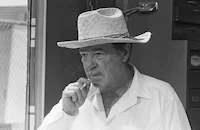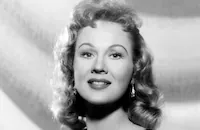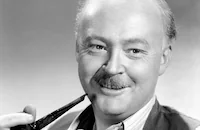The Iron Mistress

Brief Synopsis
Cast & Crew
Gordon Douglas
Alan Ladd
Virginia Mayo
Joseph Calleia
Phyllis Kirk
Alf Kjellin
Film Details
Technical Specs

Synopsis
In 1825, Jim Bowie journeys to New Orleans from his family's backwoods home in Bayou Sara to sell some lumber. His brothers caution Jim, a carefree young man whose only interest is in throwing knives, to hold out for a good price. In New Orleans, Jim makes the acquaintance of French painter James Audubon, who has angered the wealthy de Bornay family by painting birds instead of completing his portrait of the beautiful Judalon de Bornay. For verbally defending Audubon, Jim is challenged to a duel by Judalon's brother Narcisse. The challenge surprises Jim, who never intended to insult Narcisse, but Audubon explains that the upper classes of Louisiana's French-dominated society are strictly governed by "the code" of honor. Jim's use of gentle humor to prevent the duel charms Narcisse, and the two become friends. Narcisse worries, therefore, when Jim falls in love with Judalon, who is proud and spoiled. Judalon allows Jim to kiss her at a ball, but his passionate marriage proposal makes her angry, as Judalon has no intention of living on a bayou. Assuming that Jim has insulted Judalon, another suitor named Henri Contrecourt challenges him to a duel. Narcisse intervenes and is killed in the ensuing confrontation with Contrecourt. Jim then agrees to face Contrecourt, an excellent swordsman, armed only with his knife, and the two fight in a darkened chamber. To the surprise of the assembled crowd, Jim kills Contrecourt. He then sells the lumber mill and returns home with a plan to get rich by planting cotton in the bayou country. Over the next few years, the Bowies do become wealthy, but their business rivals, headed by Natchez cotton grower Juan Moreno, try to ruin them. Undeterred, Jim buys an unknown racehorse that defeats Moreno's steed in a race. Most of Moreno's cohorts pay Jim the money they bet, but Jim expects trouble and asks an expert blacksmith named Black to make him a strong knife. Black shapes a piece of a meteor into the knife, thereby making it unusually durable and sharp. Later, Jim discovers that Judalon has wed a New Orleans gentleman named Philippe de Cabanal, but after kissing Jim, she tells him that she is planning a divorce. Jim's brother suspects that she now wants to marry Moreno, but Jim is devoted to Judalon and refuses to listen. Following a duel, Moreno and his colleagues begin shooting at Jim and his friends, and after Moreno injures him, Jim stabs him to death. Judalon, unhappy because Moreno had promised to secure a bill of divorcement for her, promises to accompany Jim to a new home in Texas if he first has her husband released from a gambling debt owed to "Bloody Jack" Sturdevant. Jim defeats Sturdevant in a knife fight, but Judalon sends word that she has decided to remain with Philippe. En route to Texas, Jim is nearly killed by Sturdevant's men. He is found and nursed to recovery by Ursula de Veramendi, the Spanish daughter of the Texas vice governor. Jim soon proposes to Ursula, but she suspects he still loves Judalon. Jim returns to Louisiana to sell his lands, and on a steamboat, he encounters Judalon and Philippe. Jim learns that Philippe has lost all his money in a card game, but he exposes the gamblers as cheats and returns Philippe's money. After Judalon threatens to leave Philippe for her old admirer, the angry husband sneaks into Jim's room with a gun. At the same time, Sturdevant, seeking revenge for his earlier injury, hides in Jim's cabin, intending to kill him, but instead stabs Philippe by accident. Philippe shoots Sturdevant before dying himself, and Judalon's obvious glee at her husband's death stuns Jim. He leaves her, then drops his knife into the river and returns to San Antonio to marry Ursula.

Director

Gordon Douglas
Cast

Alan Ladd

Virginia Mayo

Joseph Calleia

Phyllis Kirk

Alf Kjellin

Douglas Dick

Tony Caruso

Ned Young
George Voskovec

Richard Carlyle

Robert Emhardt

Donald Beddoe
Harold Gordon
Gordon Nelson
Jay Novello

Nick Dennis
Sarah Selby
Dick Paxton
George Lewis
Edward Colmans
Daria Massey
David Wolfe
Ramsey Hill
Eugene Borden
Jean Del Val
Amanda Randolph
Wesley Gale
Ann Codee
Marcel De La Brosse

Juanita Moore
Frances Driver
Cecil Weston
Ivan Browning
Rudy Friml
Peter Camlin
Reed Howes
Dick Cogan
Dave Mcmahon
Charlita
Dick Bartell
Fred Rapport
Bill Griffith
Robert Strong
Madge Blake
Stanley Fraser
Roger Cole
Marshall Ruth
Lawrence Marable
Morris Buchanan
Harvey Parry
Louis Tomei
Jack Carr
Roque Ybarra
Alberto Morin
Argentina Brunetti

Frank Ferguson
Oliver Blake
Gabriel Peralta
Enrique Valadez
Juan Lopez
Primo Lopez
Gloria Varela
Dorita Pallais
Carmen Pallais
Ralph Smiley
Gayle Kellogg
W. Harry Brown
Ernest Anderson
Carlo Tricoli
Salvador Báguez
Crew
Gordon Bau
John Beckman
Marjorie Best
Henry Blanke
Alan Crosland Jr.
Murray Cutter
Oren Haglund
George James Hopkins
Stanley Jones
Mitchell G. Kovaleski
John Seitz
Max Steiner
James R. Webb

Film Details
Technical Specs

Articles
The Iron Mistress -
The movie starts as Jim Bowie (Alan Ladd) leaves his brothers and mother to head to New Orleans to trade the lumber his family has produced for market. Naturally, the first person Jim meets when he arrives in New Orleans is another famous figure from history, John James Audubon (George Voskovec), who is supposed to be painting the portrait of the beautiful Judalon de Bornay (Virginia Mayo) but can't stop painting birds and even enlists Jim's help to find a certain type of bird to paint. Meanwhile, Jim is taken with Judalon but when her brother, Narcisse (Douglas Dick), bullies Audubon, he intervenes and gets challenged to a duel. He avoids it by cleverly making it impossible. Since he is the challenged party he gets to name the time and place and weapons of choice. His time and place? New Orleans on the first snow of the year. Weapons? Snowballs. So much for that duel.
Narcisse and Jim quickly become friends and Judalon does her best to entice Jim only to rebuff him later. It's Virginia Mayo so not only is it believable that a man would gladly walk into being manipulated by her, it's also easy to believe Jim falling for it more than once. Mayo was, after all, one of the most charming "bad" women in Hollywood history. After one of those rebuffs, her other suitor, Henri Contrecourt (Ned Young), challenges Jim to a duel but Narcisse intervenes. After that intervention doesn't exactly work out for the best, Jim accepts Henri's challenge and chooses a knife for his weapon to Henri's rapier. The two fight in a darkened room with only its center lit by a skylight. It's easily the best sequence in the film and one of the best duels ever filmed, shown only in lightning flash glimpses amidst shadows and blurs.
The movie follows Bowie through his trials with Judalon and others until he leaves, invests in land and heads for Texas. It stops before any more history, like the Alamo, can get in the way. It's a slice of life, Jim Bowie style, including the magical moment when Bowie and a local blacksmith create the legendary Bowie knife.
Alan Ladd had a reputation for underplaying roles and it worked more often than not (such as his great turn as Raven in This Gun for Hire, 1942). Here he underplays once again and once again, it works. Ladd seemed to understand that to give a narrowly written character, like his famous Shane or the Hollywood historical Bowie, more mystery, the key was to play it low and quiet. The other thing Ladd understood was that given his height, around 5'6", any type of hyperventilated bravado would come off as small dog insecurity. Understanding that made Ladd the perfect actor for the quiet hero.
Virginia Mayo is the delight she always is in movie after movie. Her scheming, conniving Judalon is played with a relish that bounces off of Ladd's understatement to perfect complement. Most of their scenes are played in close-up but for long shots, such as a dance they attend, Mayo had on flats underneath her dress so as to not tower over Ladd. Other actors were chosen more for their height than anything else. Playing his two brothers were Richard Carlyle and Dick Paxton, two actors both shorter than Ladd. Casting actors smaller than Ladd meant that scenes could be shot in medium to long range, showing the actors' entire frame. In other movies, where the other actors were taller, trenches had to be dug to make them appear eye-level to Ladd.
The Iron Mistress was Alan Ladd's first movie with Warner Brothers and probably his best. It has enjoyable characters, interesting story developments, and one of the best duels ever filmed. Plus, it's got Virginia Mayo. As long as it's understood going in that it's not a history lesson by a long shot, it's a great entertainment.
Director: Gordon Douglas Producer: Henry Blanke Screenplay: James R. Webb Cinematography: John F. Seitz Music: Max Steiner Film Editor: Alan Crosland, Jr. Art Direction: John Beckman Cast: Alan Ladd (Jim Bowie), Virginia Mayo (Judalon de Bornay), Joseph Calleia (Juan Moreno), Phyllis Kirk (Ursula de Varamendi), Alf Kjellin (Phillipe de Cabanal), Douglas Dick (Narcisse de Bornay), Anthony Caruso (Black Jack Sturdevant), Nedrick Young (Henri Contrecourt), George Voskovec (John James Audubon), Richard Carlyle (Rezin Bowie), Robert Emhardt (Gen. Cuny), Don Beddoe (Dr. Cuny), Harold Gordon (Andrew Marschalk), Jay Novello (Judge Crain), Nick Dennis (Nez Coupe), Sarah Selby (Mrs. Bowie), Dick Paxton (John Bowie)
By Greg Ferrara

The Iron Mistress -
Virginia Mayo (1920-2005)
She was born Virginia Clara Jones in St. Louis, Missouri on November 30, 1920, and got her show business start at the age of six by enrolling in her aunt's School of Dramatic Expression. While still in her teens, she joined the nightclub circuit, and after paying her dues for a few years traveling across the country, she eventually caught the eye of movie mogul Samuel Goldwyn. He gave her a small role in her first film, starring future husband, Michael O'Shea, in Jack London (1943). She then received minor billing as a "Goldwyn Girl," in the Danny Kaye farce, Up In Arms (1944). Almost immediately, Goldwyn saw her natural movement, comfort and ease in front of the camera, and in just her fourth film, she landed a plumb lead opposite Bob Hope in The Princess and the Pirate (1944). She proved a hit with moviegoers, and her next two films would be with her most frequent leading man, Danny Kaye: Wonder Man (1945), and The Kid from Brooklyn (1946). Both films were big hits, and the chemistry between Mayo and Kaye - the classy, reserved blonde beauty clashing with the hyperactive clown - was surprisingly successful.
Mayo did make a brief break from light comedy, and gave a good performance as Dana Andrews' unfaithful wife, Marie, in the popular post-war drama, The Best Years of Their Lives (1946); but despite the good reviews, she was back with Kaye in The Secret Life of Walter Mitty (1947), and A Song Is Born (1948).
It wasn't until the following year that Mayo got the chance to sink her teeth into a meaty role. That film, White Heat (1949), and her role, as Cody Jarrett's (James Cagney) sluttish, conniving wife, Verna, is memorable for the sheer ruthlessness of her performance. Remember, it was Verna who shot Cody¿s mother in the back, and yet when Cody confronts her after he escapes from prison to exact revenge for her death, Verna effectively places the blame on Big Ed (Steve Cochran):
Verna: I can't tell you Cody!
Cody: Tell me!
Verna: Ed...he shot her in the back!!!
Critics and fans purred over the newfound versatility, yet strangely, she never found a part as juicy as Verna again. Her next film, with Cagney, The West Point Story (1950), was a pleasant enough musical; but her role as Lady Wellesley in Captain Horatio Hornblower R.N. (1951), co-starring Gregory Peck, was merely decorative; that of a burlesque queen attempting to earn a university degree in the gormless comedy, She¿s Working Her Way Through College (1952); and worst of all, the Biblical bomb, The Silver Chalice (1954) which was, incidentally, Paul Newman's film debut, and is a film he still derides as the worst of his career.
Realizing that her future in movies was slowing down, she turned to the supper club circuit in the 60s with her husband, Michael O'Shea, touring the country in such productions as No, No Nanette, Barefoot in the Park, Hello Dolly, and Butterflies Are Free. Like most performers who had outdistanced their glory days with the film industry, Mayo turned to television for the next two decades, appearing in such shows as Night Gallery, Police Story, Murder She Wrote, and Remington Steele. She even earned a recurring role in the short-lived NBC soap opera, Santa Barbara (1984-85), playing an aging hoofer named "Peaches DeLight." Mayo was married to O'Shea from 1947 until his death in 1973. She is survived by their daughter, Mary Johnston; and three grandsons.
by Michael T. Toole
Virginia Mayo (1920-2005)
Quotes
Ma...I killed a man.- Jim Bowie
Did he need killin'?- Mrs. Bowie
About as much as any man ever did.- Jim Bowie
Trivia
Notes
The role of "Jim Bowie" was Alan Ladd's first under his contract with Warner Bros. As Bosley Crowther remarked in his New York Times review, the film bears little resemblance to Paul Wellman's best-selling book, in which the legendary Bowie was portrayed as "something of a rascal in New Orleans in the days of Jean Lafitte." The real-life Jim Bowie was born in 1796, in either Georgia, Kentucky or Tennessee. As a young man, he moved to Texas, becoming a naturalized Mexican citizen, and in 1830, enlisted in the Texas Rangers. After fighting against the Indians, he joined the rebellion against Mexico and formed a small volunteer force. In February 1836, Bowie was designated the commander of the Alamo along with William B. Travis. When Bowie fell ill during the Mexican siege of the Alamo, however, Travis took over as sole commander. The rebels were defeated by a superior Mexican force, and Bowie was killed during the battle on March 6, 1836. Bowie is credited with inventing the Bowie knife, a weapon widely used in the old West. According to Crowther, "the early career of Bowie is thoroughly fabled and carpentered" in the film. Although Richard Crane is listed in the role of "John Bowie" in the CBCS, the part was actually played by Dick Paxton.
Since Alfred Paget's portrayal of Jim Bowie in the 1915 Triangle production, The Martyrs of the Alamo, Bowie has appeared in several films. Two films in which the character is featured prominently are the 1950 Universal production Comanche Territory, which was directed by George Sherman and starred MacDonald Carey and Maureen O'Hara, and the 1955 Republic The Last Command, which was directed by Frank Lloyd and starred Sterling Hayden. The Adventures of Jim Bowie, a television series starring Scott Forbes in the title role, aired on the ABC network from September 1956 through August 1958.















